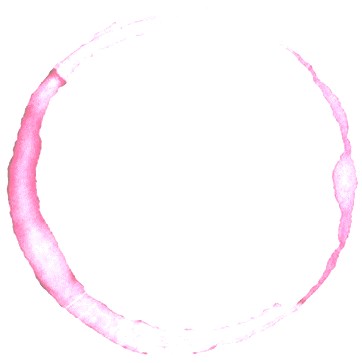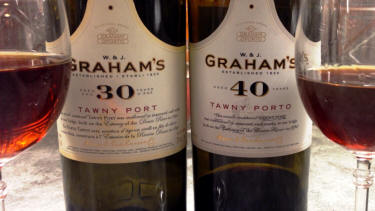
< Previous / Next >
 |
Article Index < Previous / Next > |

Comparing Graham's 30 and 40-year Tawny Port
Some time ago, I happened upon a bottle of W & J Graham’s
30-year old Tawny Port at a wine shop located in Calgary's downtown core.
Rarely is this label available in Ontario, so without hesitation, I took
advantage of the purchasing opportunity and happily stuffed the prized
acquisition into my suitcase for the flight home.
Fortified wine of this style and age does not come by way of a
bargain and this label set me back an uncomfortable amount for anyone to
shell out for a single bottle of wine on a whim. The Graham’s 30 then sat in
my cellar for another year before I finally coughed up the courage to break
the seal one evening after dinner.
For the record – and in my highly critical opinion, the Graham's 30-year
tawny port is a rare example of bottled perfection. Aromas of apricot, raisin,
fig, and honey explode from the glass preceding a velvet-like palate of
woven butterscotch threads. There were no hard edges whatsoever to deter my
enthusiasm and I ranked the wine as number 2 on my list of greatest bottles
tasted to date. [read
a
ghost in the bottle to learn more about numero uno.]
In the same wine shop, on the same shelf, two ye ars
later, I find a bottle of Graham's 40-year Tawny. Temptation can be
overwhelming in the presence of greatness and I succumb to an unwavering pressure. And
so significantly
poorer but unequivocally proud, I cradle said temptation in my arms and
cautiously avoid any uneven cracks in the sidewalk as I make my way back to the hotel.
If you haven’t figured it out yet, Calgary has some outstanding wine shops
– and I have a bit of a self-control problem…
ars
later, I find a bottle of Graham's 40-year Tawny. Temptation can be
overwhelming in the presence of greatness and I succumb to an unwavering pressure. And
so significantly
poorer but unequivocally proud, I cradle said temptation in my arms and
cautiously avoid any uneven cracks in the sidewalk as I make my way back to the hotel.
If you haven’t figured it out yet, Calgary has some outstanding wine shops
– and I have a bit of a self-control problem…
Once home, the bottle of Graham's 40 sits on display alongside five other
moments of questionable judgement, namely: Grange, la Chapelle, Haut Brion,
Échezeaux, and Corton-Charlemagne – my wife buys shoes, I buy wine; it all
balances out in the end, right?
Having tasted the 30-year effort once before, but never
the 40, the need to compare the two bottles is almost overwhelming. I
quickly set forth a plan to gather a tasting group for a blind comparison of
the two labels.
This is not the first time I have gathered this enthusiastic group to sip
and critique fine Portuguese dessert wine; three years ago, during an
afternoon of ‘Fire and Ice’, we opened five bottles of 25-year old Vintage
Port with authentic port tongs. [watch
the video] The wine on that occasion was as entertaining as it was
memorable and I promised the group that we would do it again.
Unlike its Vintage counterpart which spends nearly its entire life in the
bottle where the corks grow soft and fragile with time, there is no need for
red-hot tongs to open bottles of Tawny. The time spent within wood barrels
is the catalyst for both the difference in style and colour. The
stoppers that protect the freshly bottled Graham's 30 and 40 pose no barrier to the
contents within.
My guests arrive, each with a sinful dessert dish to pair with the
wines. I've pre-poured 2oz. per glass of each wine for every person
attending and labelled the glasses with a coloured dot. We will taste these
wines blind - not in an effort to identify the contents, but rather to
indicate our personal preference without influence from the label. In
theory, the 40-year tawny is the better wine - how could anyone dispute
that? Though in my opinion, the Graham's 30 was perfect – and I dare the 40
to demonstrate otherwise.
On initial inspection, both wines are surprisingly similar in colour and
visually there is little contrast to differentiate between the two. Tasting
reveals more variation and while both examples are a pleasure to taste, one
wine has a slight grip that leaves me wondering if I might have missed that
characteristic in my earlier tasting of the 30. I recall the wine being as
perfectly smooth and without any amount of the orange rind bitterness that
is more obvious in the 10 and 20-year tawnies by Graham's.
Many people enjoy this characteristic in their wood-aged Port – I personally
do not.
Oak influence and gradual oxidation softens the tannic structure of young fortified wines while adding a degree of complexity in the form of a
pronounced ‘nutty’ character. I find it hard to believe that any amount of
spice or bitterness could exist after 40 years in wood - and with that
assumption I pronounce the smoother tasting of the two glasses to be the
Graham's 40-year tawny and the better of the two wines.
Upon revealing the bottles, and to my surprise, I am wrong! My preference
was not for the 40. In fact, the preferred wine of the majority
attending the tasting and the smoother of the two wines was indeed the
Graham’s 30-year offering.
I've read on numerous occasions that a Port house's best tawny is typically
their 30-year
effort – and furthermore, the 40 label in each case is simply an enticing luxury for those willing to shell
out the extra shekels.
My top 10 list remains unchallenged.
| return to the Article Index |
Tyler Philp is a member of the Wine Writers' Circle of Canada Please direct inquires for writing services to: info@tylerphilp.com |
| Copyright © 2013 Tyler Philp
prior permission required for duplication of material |